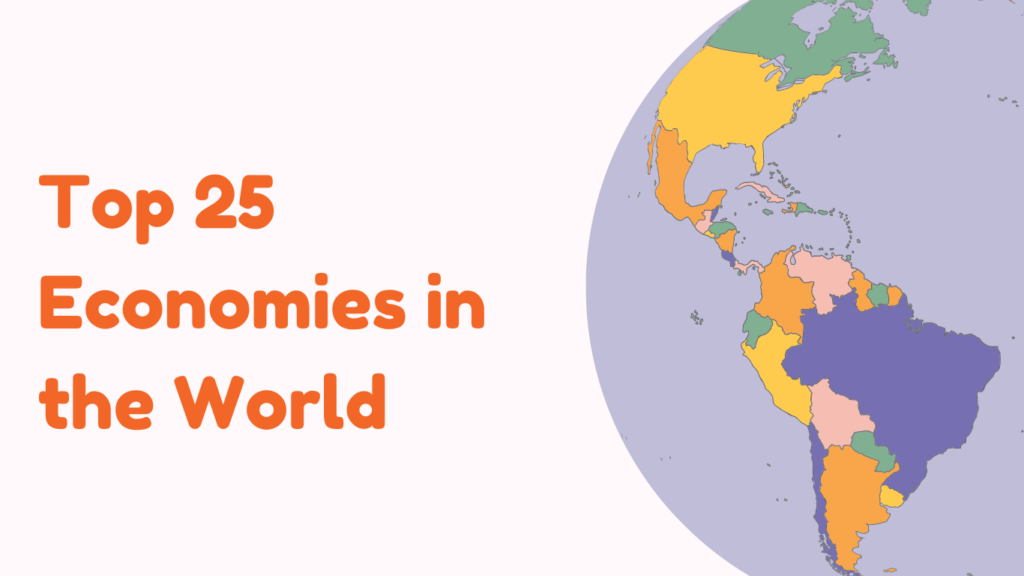Economy of the country and its impact on the global economy is measured through Gross Domestic Product (GDP). GDP is the market value of all the finished goods and services produced within a country during a specific period of time.
The list and data of the top countries with the largest GDP amounts is around $105 trillion according to the World Economy Rankings 2024.

Table of Contents
Top 25 Economies in the World
United States
GDP: $27,974 billion
GDP Per Capita: $83,060
The United States maintains the title of the largest economy in the world and the richest nation, from 1960 to 2023. The economy of the USA is driven by industries like production, trade, management, technology, finance. The US has a sizable consumer market, encourages creativity and entrepreneurship, has a strong infrastructure, and offers a favorable business environment. The US economy is experiencing 2% growth, 0 recessions, 2% inflation, and approximately 4% unemployment.
China
GDP: $18,566 billion
GDP Per Capita: $13,160
China is the fourth largest economy in the world. Manufacturing, exports and investment are the main features of Chinese market. It is pleased to have an abundant workforce, substantial backing from the government, modern infrastructure, and a rapidly growing consumer base. Growth increased to 1.6% on a quarterly basis from 1.4% over the previous three months in China.
Germany
GDP: $4,730 billion
GDP Per Capita: $56,040
Germany is ranked third. Germany is known for its precision in the engineering, automotive, chemical, and pharmaceutical industries, and its economy is heavily focused on exports. It employs the most well-trained employees worldwide. Due to a combination of high energy costs, sluggish global orders, and historically high interest rates, the German economy shrunk by 0.2% last year, the worst performance among the major economies in the euro zone.
Also Read>> Best Macroeconomics Books to Lay a Strong Foundation
Japan
GDP: $4,291 billion
GDP Per Capita: $34,550
Japan is ranked fourth in World Economy Rankings. Japan is well diversified in sectors like engineering, technology, automotive, chemicals, trade and construction. This nation’s strong economy is fueled by significant investments and a highly qualified workforce in research and development. Japan’s economy most likely shrank by an annualized 1.5%. This will likely impede the Bank of Japan’s efforts to raise interest rates.
India
GDP: $4,112 billion
GDP Per Capita: $2,850
In terms of GDP, India will be placed fifth in the world in 2024. India has the largest population in the world which boosts its GDP. India’s economy, particularly driven by major sectors like manufacturing, services, information technology, and agriculture, is diverse and growing rapidly. The country makes use of its widely spread domestic market, incredible labor force, and a growing middle class. India’s GDP will likely be grown by 8% through the 2024 fiscal year, and by 7% in the coming year.
United Kingdom
GDP: $3,592 billion
GDP Per Capita: $52,430
The UK’s huge service sector, especially in insurance, finance and management services powers the country’s economy. London is a global financial hub that attracts foreign investment. UK Long-term GDP growth is probably going to continue to be slow. We now believe that the UK had a recession in the second half of 2023 and that the country’s GDP expanded by a mere 0.3% during that year. For the duration of the prediction, we anticipate GDP to expand by 0.9% in 2024 and at a similar rate every year.
France
GDP: $3,182 billion
GDP Per Capita: $48,220
France’s economy is defined by diversification, with a focus on premium products, tourism, aerospace, and agriculture. France is recognized for its considerable investment in R&D, advanced infrastructure, and strong social welfare system. France’s economic growth in 2024 is expected to expand by just 1%, who also revealed intentions of cutting spending by €10 billion ($10.8 billion).
Italy
GDP: $2,280 billion
GDP Per Capita: $38,930
Italy’s private enterprises all contribute to the country’s GDP. There are various sectors within Italy’s economy, and each one contributes differently to GDP. It is the third-biggest economy in the EU and has a highly developed market. International economic activity showed some resilient in the first half of 2024. Unexpectedly, inflation decreased more quickly than anticipated, and job market circumstances held steady.
Brazil
GDP: $2,272 billion
GDP Per Capita: $11,030
Brazil’s economy has mining, manufacturing, agriculture industries. Additionally, it is a well-known worldwide center for exporting and producing agricultural products. In contrast to the government’s early projections, a 2.2% growth has very less impact on revenue.
Canada
GDP: $2,242 billion
GDP Per Capita: $55,530
Canada is the tenth largest economy and third largest country rich in energy with enormous oil reservoirs. Natural resources such as minerals, oil, gas, and lumber are key components for the Canadian economy. It also has a well-established manufacturing sector which contributes to its GDP.
Russia
GDP: $1.86 Trillion
GDP Per Capita: $13,010
Russia’s economy is highly vulnerable to changes in the price of the goods globally, being a significant exporter of commodities and minerals, such as gas and oil. Although the economy of Russia has moved toward greater market forces, government ownership and intervention in enterprises remains widespread.
Mexico
GDP: $1.81 Trillion
GDP Per Capita: $13,800
Mexico ranks 12th in the world economy. Mexico exports a wide range of items, including consumer electronics, auto parts, petroleum, and agricultural products. In 2024, Mexico’s economy is improved by 2.5% to 3.5% and predicted to rise by 2.0% to 3.0% in 2025.
South Korea
GDP: $1.71 Trillion
GDP Per Capita: $33,150
The country’s high technology boom and economic progress were primarily fueled by South Korea’s educational system and the creation of an educated and motivated citizens. To boost its economy, South Korea started implementing an export-focused economic policy. In Korea, the economic growth is predicted to be 2.4% in 2024.
Australia
GDP: $1.69 Trillion
GDP Per Capita: $63,490
Australia has an extensive network of free trade agreements with trading partners throughout the Asia-Pacific region, in addition to a reasonably open home economy which benefits them in the agriculture export sector and natural resources.
Also Read>>Top 10 Business Colleges in the World
Spain
GDP: $1.58 Trillion
GDP Per Capita: $33,090
Spain decreased employment costs and inflation, which raised foreign investment and its exports including food and manufactured goods. Forecasts indicate that Spain’s GDP will expand by 1.7% in 2024 and 2% in 2025, outperforming the 0.9% and 1.7% average growth of the European Union, respectively.
Indonesia
GDP: $1.42 Trillion
GDP Per Capita: $5,110
The largest economy in Southeast Asia, Indonesia, is primarily dependent on the export of commodities. Petroleum and coal are among the main exports, along with industrial agricultural products like rubber and palm oil. From 5% this year, the GDP growth is estimated to be 4.9% in 2024-26.
Türkiye
GDP: $1.15 Trillion
GDP Per Capita: $13,380
Turkey’s economy is largely open and has a strong manufacturing and service sector. Automobiles, petrochemicals, and electronics are significant sectors. The Turkish economy expanded significantly in 2023, above forecasts with a projected 4.5% annual GDP growth. In 2024, growth is predicted to slow to 3.25%.
Netherlands
GDP: $1.09 Trillion
GDP Per Capita: $61,770
The Netherlands is a major hub for international trade and transportation. It also produces a number of goods and services, including petroleum extraction and processing. GDP growth is predicted to be 0.4% in 2024 and 1.6% in 2025.
Saudi Arabia
GDP: $1.07 Trillion
GDP Per Capita: $32,590
The economy of Saudi Arabia is hugely dependent on oil. Concerns over the environment around the world are driving up the objective of developing non-fossil fuel energy sources. Saudi Arabia, along with other members of the OPEC+ oil cartel, increased its oil output limitations, changing the country’s projected GDP growth for 2024 from 2.6% to 2.7%.
Switzerland
GDP: $905.68 Billion
GDP Per Capita: $102,870
Switzerland includes not only a strong financial services industry but also a strong high-tech manufacturing sector backed by a highly skilled labor force. Growth is expected to reach 1.3% in 2024 and 1.4 % in 2025 as a result of a steady rebound in external demand, reduced inflation, and monetary policy relaxation.
Poland
GDP: $842.17 Billion
GDP Per Capita: $22,390
Poland’s economy is mainly reliant on heavy industry, which includes the production of iron and steel, machinery, coal mining, and ships. After a downturn, the Polish economy is now recovering. GDP growth is projected to be 2.6% in 2024 and 4.1% in 2025.
Taiwan
GDP: $751.93 Billion
GDP Per Capita: $32,340
Taiwan is renowned for its remarkable economic growth from a population dependent on agriculture to an industrialized, wealthy nation. In 2024, real GDP growth in Taiwan is anticipated to be 3.43%.
Belgium
GDP: $627.51 Billion
GDP Per Capita: $53,660
Belgium’s economy is diversified, with a combination of high-tech, industrial, and service sectors, and it is a hub for commerce and transportation. Belgium economy is projected to increase by 1.4% in 2024 and 1.5% in 2025.
Argentina
GDP: $621.83 Billion
GDP Per Capita: $13,300
The industrial sector contributes the most to Argentina’s GDP, following services and agriculture. Food processing, automobiles, consumer durables, textiles, chemicals, printing, metallurgy, and steel are some of its industries. Although the economy is still expected to shrink by 2.5% or more this year, the President of Argentina has managed to increase Argentina’s foreign reserves by $10 billion and create fiscal surpluses in 2024.
Sweden
GDP: $597.11 Billion
GDP Per Capita: $55,220
Sweden combines a substantial social welfare state, free entrepreneurship, and a competitive economy that produces high living standards. Sweden’s manufacturing industry is heavily dependent on imports of items like vehicles, machinery, and telecommunications equipment. Sweden’s GDP is expected to rise by 0.7 per cent in 2024 and by 2.5 per cent in 2025.
Conclusion
The world’s top 25 economies are formed with a wide range of countries with different degrees of modernization, economic growth, and importance on the international scene.
All things considered, these economies, however different in terms of size, composition, and potential for expansion, together influence the world economy and are vital to international investment, commerce, and geopolitical dynamics.
FAQs
Which parameters are used so as to identify the top 25 economies?
The Gross Domestic Product (GDP), which calculates the entire value of goods and services generated inside a nation’s boundaries in a given year, is often one of the criteria used to determine the rankings. Additional measures like industrial output, trade balance, GDP per capita, and employment rates might also be taken into account.
What factors consistently made the United States the world’s largest economy?
With strengths in technology, finance, manufacturing, and services, the US economy is extremely varied. Its enormous population and the fact that it is home to numerous international firms support its dominance in the economy.
What distinguishes India’s economy in comparison to that of other large economies?
India offers potential due to its enormous population and youthful demographic. Its economy is made up of both contemporary industries and traditional agriculture, with services becoming more and more important.






